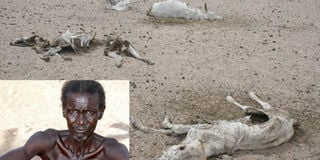Tales of suffering abound as prolonged drought continues

Cow carcasses strewn near the Gurufa borehole, Garissa District in north eastern Kenya. Inset: A starved Mzee John Chepkok, 68, of Kagir village in Kipsaraman Division Baringo North District in Rift Valley. Photos/WILLIAM OERI
The stench of cattle carcasses left to rot in the bushes is unbearable.
Flies buzz around the carcasses, occasionally landing and feasting on the remains as dogs watch from a distance. They have seemingly refused to fill their stomachs with the free food.
It is midday and the sun is quite hot. Just a few metres away, a young Maasai moran is driving a herd of about 50 emaciated cows home from the watering hole, oblivious of the foul smell.
The day has not been good for him. Despite waking up very early in the morning, his animals have not had enough water to drink and food to eat. This is now a normal happening.
But even as we struggled hard to stifle the awful stench by covering our noses with handkerchiefs, Mr Mutungi Lesingo, a resident of the Il Bissil in Kajiado Central constituency, Ruft Valley province, who is in our company, looks disturbed.
We are about 160 kilometres from Nairobi on the road to Namanga, the town on the Kenya-Tanzania border. The area is represented in Parliament by Defence assistant minister Joseph Nkaiserry.
Mr Lesingo is sadly witnessing the collapse of his “huge empire” of cattle, which took him years to amass, in a matter of days and there is nothing much he can do to save it.
The carcasses strewn all over the area were once part of his large herd of cattle. Today, they belong to flies and scavengers.
Mr Lesingo, who has four wives and 12 children, was by last December the proud owner of more than 300 head of cattle – a rich man by any standards.
But now, the number of animals in his boma (compound) is less than 150. The drought has taken its toll, not only in Kajiado, but also in the rest of the country.
In the past month alone, Mr Lesingo has lost more than 40 animals. He is not alone. The same story is replicated in other areas.
Surprisingly, goats and sheep in the area have not been much affected by the drought as they feed on the shrubs that dot the area.
According to Mr Lesingo’s Maasai culture, an individual’s riches are determined by the number of cattle he owns. The more you have, the richer you are.
Mr Lesingo says the failure of the rains has spelt doom for his cattle, which now face the twin problem of lack of pasture and water to drink.
“We are in many instances faced with a dilemma – deciding whether to feed ourselves or feed our cattle. I tell you, it’s a situation that many of Kenyans would not like to be in,” he says.
It is for this reason that the pastoralist decided to sell some of his livestock hoping to replenish the number in future.
But this has further worsened his problems. No one wants to purchase cattle on the verge of death. And like Mr Lesingo, many pastoralists facing the same predicament have brought their emaciated livestock for sale. Unfortunately, very few people are interested.
A cow that normally goes for Sh30,000 is currently being sold at as low as Sh300. And even with this low price, the businessmen still don’t attract buyers.
The pastoralist says that despite their predicaments, neither the government nor relief organisations had come to their aid, forcing several of the pastoralist communities to flee to the neighbouring Tanzania in search of pasture for their animals and food for their families.
They are now appealing to the government to come to their aid, failure of which many will continue suffering from famine.
The weatherman has already sounded a warning that the long rains are bound to delay in some area, further spelling doom for the residents.
In its latest weather outlook for the month of April, Mr Peter Ambenje, an official from the Meteorological department says pasture for livestock will continue to diminish in the pastoral areas due to the expected poor rainfall performance.
And he advises the pastoralists to destock and only remain with “strategic stock”.
Further he urges the government to rehabilitate watering points to avoid conflicts and civil insecurity that is likely to emanate from water scarcity.
Says Mr Ambenje: “In these areas, there have been a few cases of animals dying following the prolonged dry spell and poor and limited pasture conditions.”
He adds: “Some perennial rivers have even dried up due to the huge rainfall deficits for consecutive seasons.




